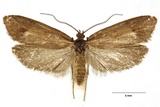Diurnea lipsiella ([Denis & Schiffermüller], 1775) Species
Last modified: Dec. 5, 2025, 6:56 p.m.
A widespread and fairly common species throughout Belgium, probably overlooked in many places because of the late flight period.
Details
- Classification
- Family: Lypusidae > Subfamily: Chimabachinae > Genus: Diurnea > Species: Diurnea lipsiella
- Vernacular names
- Herfstkortvleugelmot (NL)
- Synonyms
- Diurnea phryganella (Hübner, 1796)
- First mention in Belgium
- De Sélys-Longchamps E. 1844. Énumération des insectes Lépidoptères de la Belgique. — Mémoires de la Société royale des Sciences de Liége 2: 1–35. On page 23 (as Lemmatophila phryganella Schr.). view page
- Status
-
Native
Distribution
Caterpillar
Yellowish green, head capsule brown, prothoracic plate yellow.
Bionomics
The species probably hibernates in the egg stage. The eggs are oviposited on a twig or the bark of the larval hostplant.
The caterpillar spins two leaves together or folds the margin of one leaf downwards. The first instars do not skeletonize the leaf but eat the entire leaf area. The development of the larva is much faster than in Diurnea fagella. They can be found from June till early August.
Pupation amongst leaf litter on the ground in the period August–October.
Males fly during the day in sunshine, mainly from noon till late afternoon on warm windless days, and later they come to light. They have been observed fluttering amongst low plants on the forest floor while assembling to females. Females hide low to the ground in bushes or on lower branches of trees.
Flight periods
One generation a year from the end of September till mid-November.
Observed on
- Host plant (species):
- Carpinus betulus
- Host plant (genera):
- Quercus
- Substrates:
- Polyphagous
Polyphagous. The larva lives in a folded or rolled leaf mainly on Carpinus betulus or Quercus petraea and several other species of Fagaceae. It has also been recorded from Acer, Alnus, Amelanchier, Betula, Crataegus, Fagus sylvatica, Fragaria, Fraxinus, Geum, Malus, Populus, Prunus, Quercus, Rosa, Rubus, Sorbus, Tilia, and Vaccinium myrtillus.
Habitat
Different kinds of deciduous and mixed forests, mainly Fageto-Quercetum with a lot of open spaces, bushes, gardens.







